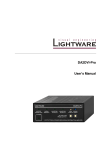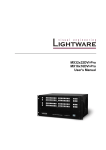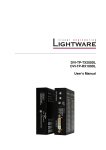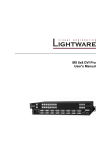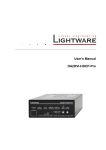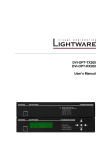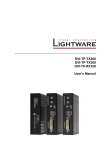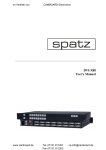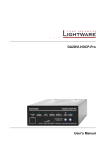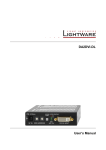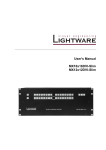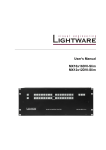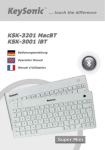Download DA2DVI-Pro User`s Manual
Transcript
DA2DVI-Pro User's Manual Page 2 / 43 DA2DVI-Pro User’s Manual v1.0 SAFETY INSTRUCTIONS Class II apparatus construction. This equipment should be operated only from the power source indicated on the product. To disconnect the equipment safely from power, remove the power cord from the rear of the equipment, or from the power source. The MAINS plug is used as the disconnect device, the disconnect device shall remain readily operable. There are no user-serviceable parts inside of the unit. Removal of the top cover will expose dangerous voltages. To avoid personal injury, do not remove the top cover. Do not operate the unit without the cover installed. The apparatus shall not be exposed to dripping or splashing and that no objects filled with liquids, such as vases, shall be placed on the apparatus. The apparatus must be safely connected to multimedia systems. Follow instructions described in this manual. WEEE ( W as te E l e c tr ic a l & E lec tr on ic Eq u ipm en t) Co rr e ct Di sp o s al o f T h is P ro d u ct This marking shown on the product or its literature, indicates that it should not be disposed with other household wastes at the end of its working life. To prevent possible harm to the enviroment or human health from uncontrolled waste disposal, please separate this from other types of wastes and recycle it responsibily to promote the sustainable reuse of material resources. Household users should contact either the retailer where they purchased this product, or their local government office, for details of where and how they can take this item for environmentally safe recycling. Business users should contact their supplier and check the terms and conditions of the purchase contract. This product should not be mixed with other commercial wastes for disposal. Page 3 / 43 DECLARATION OF CONFORMITY We, Lightware Kft. 1071 Budapest Peterdy str. 15 HUNGARY as manufacturer declare, that the products DA2DVI-Pro ( Video Distribution Amplifier ) in accordance with the EMC Directive 2004/108/EC and the Low Voltage Directive 2006/95/EEC is in conformity with the following standards: EMI/EMC ..................................... EN 55022 Class B Safety........... UL, CUL, GS, CR, RCM, PSE, Class II Date: 01 September 2009 Name: Gergely Vida ( Managing Director ) Signed: Page 4 / 43 DA2DVI-Pro User’s Manual v1.0 Table of contents 1. GENERAL DESCRIPTION..............................................................................................................7 1.1. BOX CONTENTS .........................................................................................................................7 1.2. FEATURES ................................................................................................................................7 1.3. ADVANCED EDID MANAGEMENT ................................................................................................8 1.4. PIXEL ACCURATE RECLOCKING ..................................................................................................8 1.5. FIBER CABLE POWERING......................................................................................................... 10 1.6. CASCADING MULTIPLE DA2DVI-PROS ..................................................................................... 10 1.7. FRONT AND REAR VIEW ........................................................................................................... 11 1.7.1. Front panel view .......................................................................................................... 11 1.7.2. Rear panel view ........................................................................................................... 12 1.8. ELECTRICAL CONNECTIONS ..................................................................................................... 13 1.8.1. DVI inputs and outputs ................................................................................................ 13 1.8.2. USB control port .......................................................................................................... 14 2. OPERATION ................................................................................................................................ 15 2.1. 2.2. 2.3. 2.4. POWER .................................................................................................................................. 15 LEARNING AN EDID ................................................................................................................ 15 SWITCHING THE EDID ............................................................................................................ 16 FACTORY PRESET EDID LIST .................................................................................................. 16 3. FRONT PANEL CONTROL - DIP SWITCH SETTINGS .............................................................. 17 4. SOFTWARE CONTROL – USING LIGHTWARE MATRIX CONTROLLER ............................... 18 4.1. ESTABLISHING THE CONNECTION ............................................................................................. 18 4.2. CONTROL MENU – INPUT AND OUTPUT STATES ......................................................................... 19 4.3. EDID MENU ........................................................................................................................... 20 4.3.1. EDID Router operation ................................................................................................ 20 4.3.2. Advanced EDID Editor ................................................................................................ 22 4.4. TERMINAL MENU ..................................................................................................................... 22 4.5. STATUS MENU ...................................................................................................................... 23 4.6. FIND MENU ............................................................................................................................. 23 4.7. OUTPUT SETTINGS ................................................................................................................. 24 4.8. CONTROL COMMANDS............................................................................................................. 26 4.8.1. View product type ........................................................................................................ 26 4.8.2. View serial number ...................................................................................................... 26 4.8.3. View firmware version ................................................................................................. 26 4.8.4. Route EDID to the input (static) .................................................................................. 26 4.8.5. Route EDID to the input (dynamic) ............................................................................. 27 4.8.6. Save EDID from output to memory location (Learn EDID) ......................................... 27 4.8.7. View EDID validity table .............................................................................................. 28 4.8.8. View EDID header ....................................................................................................... 28 4.8.9. Upload EDID content from the DA2DVI-Pro ............................................................... 28 4.8.10. Download EDID content to the DA2DVI-Pro ............................................................... 29 4.9. DA2DVI-PRO INITIATED COMMANDS ....................................................................................... 30 4.9.1. EDID status changed .................................................................................................. 30 4.9.2. Port status changed .................................................................................................... 30 4.9.3. Error responses ........................................................................................................... 30 4.10. INPUT AND OUTPUT PORT STATUS ............................................................................................ 31 4.10.1. Check the status of the inputs ..................................................................................... 31 4.10.2. Check the status of the outputs ................................................................................... 31 5. FIRMWARE UPGRADE ............................................................................................................... 32 6. TROUBLESHOOTING ................................................................................................................. 36 6.1. 6.2. USB CONNECTION PROBLEMS................................................................................................. 36 THERE IS NO PICTURE ............................................................................................................. 36 Page 5 / 43 6.3. 7. THERE IS NO INPUT SIGNAL ...................................................................................................... 37 MECHANICAL DRAWINGS ......................................................................................................... 38 7.1. 7.2. 7.3. 7.4. FRONT VIEW ........................................................................................................................... 38 REAR VIEW ............................................................................................................................. 38 TOP VIEW ............................................................................................................................... 39 BOTTOM VIEW......................................................................................................................... 40 8. WARRANTY ................................................................................................................................. 41 9. SPECIFICATIONS ........................................................................................................................ 42 Page 6 / 43 DA2DVI-Pro User’s Manual v1.0 1. General description 1.1. Box contents − DA2DVI-Pro Distribution Amplifier − User's manual − Quick Start Guide − +5V wall plug power adaptor − CD-ROM with control software − USB Type A/B cable 1.2. Features 60 meter input cable compensation – Using 22AWG high quality DVI cable, the input is automatically compensated for up to 60 meter cable length, which extends installation possibilities even on highest HDTV or computer resolutions. In case of lower pixel resolutions, this length can be even higher. Advanced EDID Management – The user can emulate any EDID on the DA2DVIPro’s input, read out and store any monitor's EDID (attached to Output 1) in 49 internal memory locations, upload and download EDID files using Matrix Control Software. Supports all HDTV resolutions – 720p, 1080i and 1080p etc. without HDCP encoding - Unencrypted HDTV signals up to 165 MHz pixel clock frequency regardless of the resolution passed through. Pixel Accurate Reclocking – (removes jitter and skew caused by long cables) each output has a clean, jitter free signal, eliminating signal instability and distortion caused by long cables or connector reflections. Signal Present LED – Valid DVI signal is detected, when signal is applied to DVI INPUT. Source and Monitor Connected LEDs – Three LEDs indicate when a DVI source and display diveces are connected to the DA2DVI-Pro. Front and rear panel control – EDID Address selection with two decimal rotary switches and Learn EDID button are available on the front panel. Advanced hardware settings can be made with DIP switch on the rear side of the DA2DVI-Pro. Software control – Input status, output settings, EDID Management, Terminal Window and hardware information can be accessed in Lightware Matrix Controller software using a USB connection. Fiber cable support – Self powered DVI fiber cables using +5V from DVI sources (VGA cards, etc.) usually consume more than 50 mA, which load is maximum allowed by DVI 1.0 standard. DA2DVI-Pro supports +5V 500 mA constant current output on each DVI OUTPUT to power long distance fiber optical cables. Universal power adaptor – DA2DVI-Pro is equipped with a universal +5V power adaptor, which accepts AC voltages from 100 to 240 Volts with 50 or 60 Hz line frequency. Page 7 / 43 1.3. Advanced EDID Management Each DVI sink (e.g. monitors, projectors, plasma displays, and switcher inputs) must support the EDID data structure. Source BIOS and operating systems are likely to query the sink using DDC2B protocol to determine what pixel formats and interface are supported. DVI standard makes use of EDID data structure for the identification of the monitor type and capabilities. Most DVI sources (VGA cards, set top boxes, etc) will output DVI signal after accepting the connected sink’s EDID information. In case of EDID readout failure or missing EDID the source will not output DVI video signal. DA2DVI-Pro provides Lightware’s Advanced EDID Management function with functions that help system integration. The built-in EDID Manager stores and emulates 100 EDID plus the EDID of the display device which is connected to DVI OUTPUT 1. Memory addresses from 01 to 50 are factory presets, while memories from 51 to 99 are user programmable. The DA2DVI-Pro stores the EDID of the monitor or projector connected to DVI OUTPUT 1 in a non-volatile memory. The EDID emulated on the input can be copied from the DA2DVI-Pro's memory (static EDID emulation) or from the attached monitor (dynamic EDID emulation). For example, the DA2DVI-Pro can be set up to emulate the device, which is connected to DVI OUTPUT 1, and the EDID automatically changes, if the monitor is replaced with another display device (as long as it has a valid EDID). The user is not required to disconnect the DVI cable to change an EDID as opposed to other manufacturer’s products. EDID can be changed even if source is connected to the input and powered ON. Info 1.4. Pixel Accurate Reclocking DA2DVI-Pro reclocks the signal on all outputs using Lightware’s sophisticated Pixel Accurate Reclocking technology. Signal reclocking is an essential important procedure in digital signal transmission. After passing the reclocking circuit, the signal becomes stable and jitter-free, and can be transmitted over more equipment like processors, or event controllers. Without reclocking, sparkles, noise and jaggies can be seen on the image. The Pixel Accurate Reclocking circuit eliminates the following errors: Intra-pair skew: skew between the + and - wires within a differential wire pair (e.g. Data2- and Data2+). It’s caused by different wire lengths or slightly different wire construction (impedance mismatch) in DVI cable. It results in jitter. Page 8 / 43 DA2DVI-Pro User’s Manual v1.0 Inter-pair skew: skew between two differential wire pairs in a cable. It’s caused by different wire pair lengths or different number of twists in the DVI cable. Too much inter-pair skew results in color shift in the picture or sync loss. Jitter: signal instability in the time domain. The time difference between two signal transitions should be a fix value, but noise and other effects cause variations. Noise: electromagnetic interference between other electronic devices such as mobile phones, motors, etc. and the DVI cable are coupled onto the signal. Too much noise results in increased jitter. The Pixel Accurate Reclocking circuit completely regenerates the original video signal and outputs a strong, high-quality digital signal that conforms to the DVI specification. Page 9 / 43 1.5. Fiber Cable powering As special feature DA2DVI-Pro is able to supply 500 mA current to power fiber optical transmitters like DVI-OPT-TX100 (Pin 14 on both DVI output connectors). Standard DVI outputs or VGA cards supply only 55 mA current on +5V output, thus unable to directly power a fiber optical cable. Info DA2DVI-Pro does not check if the connected sink (monitor, projector or other equipment) supports Hotplug or EDID signals but outputs the signal immediately after it has been applied to the input. 1.6. Cascading multiple DA2DVI-Pros Thanks to the built-in cable equalizer and the Pixel Accurate Reclocking circuit, up to 8 DA2DVI-Pros can be cascaded. This feature is especially useful for digital signage applications. The distance between the display blocks may be up to 60 meters in case of HD 1080p resolution, or even higher for lower pixel numbers or interlaced scan 1080i. If the display devices have different resolutions, please emulate the EDID of the display that has the lowest resolution, otherwise the displays with higher resolutions may not show the whole image, rescale the image or won’t display an image at all. Digital signage application Page 10 / 43 DA2DVI-Pro User’s Manual v1.0 1.7. Front and rear view 1.7.1. Front panel view Status LEDs Power LED Learn EDID button Address selection Source connected LED Indicates if a DVI source is connected to the DA2DVI-Pro, it is powered on and sends +5V signal to Pin 14 of the input DVI connector. Signal present LED Indicates if a valid DVI clock signal is present on the input DVI connector. Monitor 1 hotplug LED Indicates if a display device (or matrix switcher, repeater, etc.) is connected to the DVI OUTPUT 1 connector and sends a valid Hot Plug Signal on Pin 16 through the DVI cable. Monitor 2 hotplug LED Indicates if a display device (or matrix switcher, repeater, etc.) is connected to the DVI OUTPUT 2 connector and sends a valid Hot Plug Signal on Pin 16 through the DVI cable. EDID status LED Function 1: displays the firmware version of the device. For more information, see chapter 2.1. Function 2: after applying a Hot Plug signal to DVI OUTPUT 1, this LED indicates that the unit is reading the EDID from the connected display device. If the LED is blinking green then the EDID is valid, if blinking red, then the EDID is invalid or missing. Function 3: this LED indicates whether the selected EDID is valid (continuous green = valid, continuous red = invalid or empty memory selected). EDID address selection can be done by front panel rotary switches or Matrix Controller software. Learn EDID button Stores the EDID of the display device attached to DVI OUTPUT 1 in the selected memory address (50…99). To learn the EDID, select an appropriate address with the rotary switches and press and hold the Learn button for two seconds. Power LED Indicates if the device is powered on. It does not indicate whether the device is operating properly. Address selection The rotary switches select one of 100 addresses. Addresses 1…50 are factory preset and 51…99 are user programmable. Use a flat head screwdriver that fits into the actuator. Avoid use of keys, coins, knives and other sharp objects because they might cause permanent damage to the rotary switches. Page 11 / 43 1.7.2. Rear panel view DVI INPUT +5V DC DVI OUTPUT 1 DIP switch USB connector DVI OUTPUT 2 DVI INPUT Connect one single link DVI-D or DVI-I cable (only digital pins are connected internally) between the DVI source and DA2DVIPro. The built-in automatic cable equalization circuit compensates for up to 60 meters at 1920x1080p 60 Hz resolution. For lower resolutions, even longer cables can be used. DIP switch 8 circuit DIP switch, which selects the Control Mode, TMDS PLL Frequency, Deskew value, Pixel PLL enable and Pixel Phase clock. For more information, please see section 3. USB connector USB Type B female connector for remote control using Lightware Matrix Controller software. Connect a USB Type A/B cable between the DA2DVI-Pro and the controlling PC or laptop. +5V DC connector Connect the output of the supplied +5V power adaptor. CAUTION! Warranty void if damage occurs due to use of a different power source. DVI OUTPUT 1 Connect one single link DVI-D or DVI-I cable (only digital pins are connected internally) between DA2DVI-Pro and display device. EDID functions are enabled only on this output. The output connector is able to supply 500 mA current on pin 14 to power fiber optical DVI extenders like DVI-OPT-TX100. If a long DVI cable is connected then equalization may be necessary at the other end of the cable. DVI OUTPUT 2 Connect one single link DVI-D or DVI-I cable (only digital pins are connected internally) between DA2DVI-Pro and display device. EDID functions are not available on this output. The output connector is able to supply 500 mA current on pin 14 to power fiber optical DVI extenders like DVI-OPT-TX100. If a long DVI cable is connected then equalization may be necessary at the other end of the cable. Page 12 / 43 DA2DVI-Pro User’s Manual v1.0 1.8. Electrical connections 1.8.1. DVI inputs and outputs DA2DVI-Pro provides 29 pole „digital only” DVI-I connectors for input and output connections. Always use high quality DVI cable for connecting sources and displays. The input has a built-in signal detection circuit with a LED indicator located on the front panel. The LED lights green, if the input connector senses a valid DVI signal. Pin Signal Pin Signal Pin Signal 1 TMDS Data2- 11 TMDS D1/3 Shield 21 TMDS Data5+ (nc) 2 TMDS Data2+ 12 TMDS Data3- (nc) 22 TMDS Clk Shield 3 TMDS D2/4 Shield 13 TMDS Data3+ (nc) 23 TMDS Clock+ 4 TMDS Data4- (nc) 14 +5V Power 24 TMDS Clock- 5 TMDS Data4+ (nc) 15 GND (for +5V) 25 R (not connected) 6 DDC Clock 16 Hot Plug Detect 26 G (not connected) 7 DDC Data 17 TMDS Data0- 27 B (not connected) 8 VSYNC (nc) 18 TMDS Data0+ 28 HSYNC (nc) 9 TMDS Data1- 19 TMDS D0/5 Shield 29 Analog GND 10 TMDS Data1+ 20 TMDS Data5- (nc) Table 1. DVI-I “digital only” connector pin assignments Cable length at inputs DA2DVI-Pro has an advanced built-in cable equalization circuit, which automatically provides cable length compensation. This circuit extends the maximum usable cable length to 60 meters using high quality 22AWG copper cable at WUXGA 1920x1200 graphics resolution. 22 AWG 24 AWG Reference type Reference type DVI GEAR: SHR DVI TASKER: TSK 1060 Resolution Max length (meter) Max length (meter) 1920x1200; 1600x1200; 2048x1080p; 1080p 60 m 50 m 1680x1050; 1400x1050; 1280x1024 75 m 62 m 1024x768; 1365x768; 720p; 1080i; 92 m 77 m 800x600 100 m (calculated) 84 m (calculated) 640x480; 480p; 576p 120 m (calculated) 100 m (calculated) Cable type Signal Table 2. Maximum DVI cable lengths at inputs Page 13 / 43 1.8.2. USB control port DA2DVI-Pro can be remote controlled via a commonly used USB connector located on the rear panel of the unit. Connect a USB Type A/B cable between the DA2DVI-Pro and the controlling PC or laptop. Please make sure not to send any commands to the DA2DVI-Pro via the USB port until it has finished the booting process (EDID Status LED continuously illuminated green or red). Doing so may result in faulty behavior, in which case please restart the DA2DVI-Pro. Pin 2 Pin 3 Pin 1 Pin nr. Signal 1 +5V 2 Data- 3 Data+ 4 GND Pin 4 USB Type B port pin locations Table3. – USB Type B pin connections After connecting the DA2DVI-Pro to the control PC or laptop, the driver of the device starts installing itself. Normally this is an automatic process. The driver creates a virtual COM port in the operating system. When running the Lightware Matrix Controller software, this COM port will be seen in the Available Serial Ports list. If the DA2DVI-Pro does not install its driver automatically, please visit the following website and download the VCP (Virtual COM Port) driver for your operating system and install it. http://www.ftdichip.com/Drivers/VCP.htm For further assistance, please contact [email protected] Page 14 / 43 DA2DVI-Pro User’s Manual v1.0 2. Operation 2.1. Power When building an electronic system, make sure that all of the devices are powered down before connecting them. Powered on devices may have dangerous voltage levels that can damage sensitive electronic circuits. 1. After the system is complete, connect the the +5V Power Adaptor to the DA2DVI-Pro. The unit is immediately powered ON. After the DA2DVI-Pro is initialized, the attached DVI source and monitor(s) can be powered on. 2. After powered on, the DA2DVI-Pro displays its firmware version using the EDID Status LED. The following example shows this process for a firmware version of 1.3.7 RED blinks once → Short pause → GREEN blinks three times → Short pause → GREEN blinks seven times → Short pause → The normal function of the LED is in effect. 3. After indicating the firmware version, the EDID STATUS LED turns green if the selected EDID is valid, or turns red, if the selected EDID is invalid. 4. If a display device is connected to DVI OUTPUT 1, the DA2DVI-Pro reads the EDID from the attached monitor’s EDID memory. If the read process is successful, the GREEN LED blinks a few times and stays illuminated. If the read process is unsuccessful, the RED LED blinks a few times, and then the green LED becomes continuously illuminated. This means that the read process failed and the last valid EDID is switched to the input. Info If none of the LEDs light up upon power-up, the unit is most likely damaged and further use is not advised. Please contact [email protected] 2.2. Learning an EDID The factory preset EDIDs cannot be changed by the user. Only addresses from 51 to 99 are user programmable. 1. After connecting the sink device to DVI OUT 1, use a screwdriver to select the desired memory address. EDID are stored in multiple programmable non-volatile memories. If the EDID status LED is illuminated RED, then the memory slot is empty and ready to be programmed. If GREEN, the memory was already used before, but still available for programming. 2. Push the LEARN button on the front side of the DA2DVI-Pro and hold it down for approximately 3 seconds. Once the button is pushed the EDID status LED goes dark. If the storing was successful, the GREEN EDID status LED blinks five times and stays illuminated. If the store process was unsuccessful, the RED EDID status LED blinks five times and stays illuminated. Page 15 / 43 2.3. Switching the EDID 1. Use a screwdriver to change the memory address on the front side of the DA2DVI-Pro. After either one of the rotary switches has been rotated the unit waits approximately 2 seconds before the selected EDID becomes active. If the EDID status is unchanged the EDID STATUS LED does not blink. 2. The address 00 (zero zero) has a special function. If a monitor is connected to DVI OUTPUT 1, then its EDID is copied to the DVI INPUT. If no monitor is connected to the Monitor output then the EDID provided on the DVI INPUT connector is the EDID of the last connected monitor. Info If an invalid EDID is selected, the DA2DVI-Pro does NOT transmit a HOT PLUG signal to the source connected to the DVI INPUT. Info After every EDID change, DA2DVI-Pro toggles the HOT PLUG signal for approx. 1 sec. Some graphic cards or DVD players do not sense the HOT PLUG signal, and even if EDID has been changed, the set resolution is not affected. In this case the source device must be restarted, or powered OFF and ON again. 2.4. Factory preset EDID list Lightware factory preloaded EDID are specially provided to force graphic cards to output only the exact pixel resolution and refresh rate. Universal EDID (address 49) allows multiple resolutions including all common VESA defined resolutions. In addition, it also features audio support. The use of universal EDID is advised for fast and easy system setup. MEMORY Resolution MEMORY 640x480@60 Hz 26 1600x1200@50 Hz 02 03 640x480@75 Hz 848x480@60 Hz 16:9 27 28 1600x1200@60 Hz 1920x1200@60 Hz 04 800x600@50 Hz 29 1920x1200@50 Hz 05 800x600@60 Hz 30 [email protected] Hz 06 800x600@75 Hz 31 [email protected] Hz 07 1024x768@50 Hz 32 720x480p@60 Hz 08 09 1024x768@60 Hz 1024x768@75 Hz 33 34 576i@50 Hz 720x576p@50 Hz 10 1152x864@75 Hz 35 1280x720p@50 Hz 11 1280x768@50 Hz 36 1280x720p@60 Hz 12 1280x768@60 Hz 37 1920x1080i1 @50 Hz 13 1280x768@75 Hz 38 1920x1080i2 @50 Hz 14 15 1360x768@60 Hz 1364x768@50 Hz 39 40 1920x1080i@60 Hz 1920x1080p@24 Hz 16 1364x768@60 Hz 41 1920x1080p@25 Hz 17 1364x768@75 Hz 42 1920x1080p@30 Hz 18 1280x1024@50 Hz 43 1920x1080p1 @50 Hz 19 1280x1024@60 Hz 44 1920x1080p2 @50 Hz 20 21 1280x1024@75 Hz 1366x1024@60 Hz 45 46 1920x1080p@60 Hz 2048x1080p1 @50 Hz 22 1400x1050@50 Hz 47 2048x1080p2 @50 Hz 23 1400x1050@60 Hz 48 2048x1080p@60 Hz 24 1400x1050@75 Hz 49 UNIVERSAL EDID 25 1680x1050@50 Hz 50 2560x1600@60 Hz Table 3. Factory Preset EDID list Page 16 / 43 Resolution 01 DA2DVI-Pro User’s Manual v1.0 3. Front panel control - DIP switch settings Advanced users can make adjustments using an 8 circuit DIP switch located on the rear panel of the DA2DVI-Pro (see chapter 1.7.2). SW 1: defines whether the DA2DVI-Pro is controlled by the rotary switches and the DIP switch or the Lightware Matrix Controller software via USB connection. SW 2-3: if the incoming signal has too much jitter resulting from a low quality source, then a higher TMDS PLL filter frequency may be necessary. The default value of 4 MHz should provide the best results in most cases. CAUTION! Setting a higher frequency slightly decreases the quality of the output signal. SW 4-5-6: if the clock and pixel data are not perfectly aligned in the internal pixel signal, then there’s a possibility to add some skew between them in both directions. There is no widely accepted value, because it depends on the resolution and pixel clock. A default setting of -2 should provide the best results in most cases. SW 7: it is recommended to enable the Pixel PLL at all times. If the quality of the incoming signal is too low and the other settings could not improve the quality, then disabling the Pixel PLL may be necessary. SW 8: this is a coarse way to adjust the deskew value. This setting shifts the phase of the clock signal by 180 degrees. Page 17 / 43 4. Software Control – Using Lightware Matrix Controller 4.1. Establishing the connection The unit can be controlled using Lightware Matrix Controller software from a PC or Laptop via USB port. 1. Info Turn DIP Switch 1 in ON position to enable USB control function. USB Connection to the DA2DVI-Pro can be done even if it’s in front panel control mode, but only the status of the settings can be checked, and no software changes can be applied. 2. Connect a USB Type A/B cable between the PC and the DA2DVI-Pro. The unit installs its driver automatically. If the installation process fails, see chapter 1.8.2. 3. To run the CONTROL SOFTWARE, double click on the icon of the software on the desktop or select the proper shortcut from Start Menu/ Programs/ Lightware folder. 4. Select the appropriate virtual COM port and click on Connect. Info The device Type and Serial number are not listed automatically for COM ports. To query the Type and Serial number, double click on the desired COM port. Info After connecting the DA2DVI-Pro to the controlling PC or laptop, the driver of the DA2DVI-Pro starts installing itself. The driver creates a virtual COM port in the operating system. When running the Lightware Matrix Controller software, this COM port will be seen in the Available Serial Ports list. Page 18 / 43 DA2DVI-Pro User’s Manual v1.0 5. After clicking on the Connect button, the Lightware Matrix Controller finds the hardware, recognizes the product type, and a button matrix area (crosspoint area) appears according to the input and output numbers of the device. For DA2DVI-Pro, I1 column represents the input, O1 and O2 rows represent the outputs. Regardless of the fact that a crosspoint switching area appears, the input signal is always routed to both outputs by default. Crosspoint area 4.2. Control menu – Input and output states Each input and output label has a colored background according to its state, so the user can see the main information with a quick look at them. Legend for input labels: No source is connected. The power +5V is not present. Source is connected (+5V present), but there is no active DVI signal. DVI signal is present on the link. Legend for output labels: There is no device connected or the connected device is turned off. Hotplug is present, a sink is connected. Info: Staying with the cursor above a label shows a hint about these states. Page 19 / 43 4.3. EDID menu 4.3.1. EDID Router operation By clicking on the EDID menu, the EDID router window appears. When the user enters the menu for the first time, the software starts to download the whole EDID content from the DA2DVI-Pro. It may take about 10-20 seconds. After the list is downloaded, the current status of the EDID list is shown in two windows (list window areas). In the drop-down menus above the two windows you can select which part of the EDID memory you want to see. The Emulated EDID List window contains the resolution, manufacturer and vendor name of the EDID emulated or reported to the source. The source column displays the memory location that the current EDID was routed from. The Last attached Monitor's EDID List window contains the resolution, manufacturer and vendor name of the display device connected to DVI OUTPUT 1. The Factory EDID List window shows the fifty factory preprogrammed EDID. The User EDID List shows the memory locations which can be used by the user to save EDID. List window areas Change emulated EDID at the input – Drag and Drop The two main types of the emulation are the static and the dynamic: Page 20 / 43 Static EDID emulation: when an EDID from memories 1…100 is selected and emulated at the input(s) Dynamic EDID emulation: when an attached monitor’s EDID is emulated at input(s), simply copying the data from the monitor. This EDID changes immediately and automatically, if a new monitor is attached to the output. DA2DVI-Pro User’s Manual v1.0 The process of emulating an EDID is the following: 1. Select the Emulated EDID List in one of the list window areas in the dropdown menu. 2. Select the desired EDID from one of the list windows. 3. Drag and drop the EDID to the desired location in the Emulated EDID list. Info: If the monitor’s EDID was selected to be emulated (DVI OUTPUT 1) the currently emulated EDID will be changed on the input every time a new monitor is connected. If the monitor is disconnected from the output, the last EDID remains active, it will not be deleted from the input. This feature helps especially rental technicians or system integrators to keep the source continuously transmitting the signal, and adopt the system for new incoming display devices. Info: Power ON/OFF cycle will not affect the emulated EDID or other settings. Info: EDID switch procedure causes a status change and hence it is reported back to the CONTROL SOFTWARE within 2-3 seconds. Learn EDID from attached display device The system is able to learn the EDID from the connected display device and store it in one of the user programmable memory locations. 1. Select User Memory in one of the list window areas in the drop-down menu. 2. Select the EDID to be saved from the other list window. 3. Drag and drop the selected EDID to the desired User Memory location. Load EDID from file to memory The DA2DVI-Pro is able to learn and store EDID from a file located on the computer. EDID are stored in *.dat files. 1. Select the User Memory list window from one of the drop-down menus, and right click on the desired memory location. Then select “Load from file” from the pop-up menu. 2. Browse your hard drive to find the EDID file in the pop-up window. The software checks whether the selected file is a valid EDID file. 3. Click Open in the browser window. After the process finished, ”EDID Upload completed” message appears. Save EDID from memory to file The control software is able to download EDID from the DA2DVI-Pro and to save it as an EDID file. 1. Right click on the EDID to be saved. 2. Click on Save to file in the pop-up window. 3. The Matrix Controller Software downloads the desired EDID and a save dialog appears. It may take a few seconds to download the EDID. If the save dialog is shown, type in the file name, and press Save button. After the process was completed, an ”EDID saved!” message confirms the command. Page 21 / 43 Synchronize EDID By clicking on Synchronize EDID List button the Lightware Matrix Controller software rereads all EDID information from the connected DA2DVI-Pro. During normal operation it is not necessary to use this menu function because the DA2DVI-Pro always reports every status change automatically. No status change is reported, if you emulate the same EDID on the input or connect the same display device to DVI OUTPUT 1. Info: There is always a small delay in responses. So if a new monitor is connected to DVI OUTPUT 1, its new EDID is not shown immediately but in 2-3 seconds! 4.3.2. Advanced EDID Editor The Lightware Advanced EDID Editor is integrated into the Lightware Matrix Controller software. By clicking on the green arrow, the editor area rolls down. When the user enters the menu for the first time, an empty EDID is loaded into the editor’s memory. All EDID in the DA2DVI-Pro’s memory can be edited in the following way: 1. Right click on the desired EDID to be loaded to the EDID Editor. 2. In the pop-up menu, click on Edit EDID. The editor area automatically rolls down, and the EDID is loaded into the editor area. For further information, see the user’s manual of Advanced EDID Editor. 4.4. Terminal menu This general-purpose serial terminal is intended mainly for test and debug purposes. After a successful connection to the DA2DVI-Pro this terminal can be opened and used via the USB connection. All commands can be used here that are discussed in section 1.1 and can be typed directly. Terminal window Commands are surrounded by framing brackets by default. Every sent command and every received response gets an arrow (-> or <-) prefix, and has different font colors in order to help distinguishing. Page 22 / 43 DA2DVI-Pro User’s Manual v1.0 4.5. STATUS menu Basic device information, such as device name, firmware version, the input and output cards’ hardware revisions are displayed in this window. 4.6. Find menu By selecting this menu option, the available devices can be rescanned on the COM ports and on the Ethernet. If the Matrix Controller Software has a live connection to a device on a port, a question window appears, asking if you really want to disconnect from the currently controlled device. Page 23 / 43 4.7. Output Settings A right click on the output port label (O1 or O2) near the crosspoint field will open the Set DVI parameters window. Apply changes to Current output: this option means the modified parameters are applied only to the currently selected port displayed in the header. All outputs: Info: this option means that the modified parameters are applied to all output ports. After closing this window, the Current Output option will be selected regardless of which was active at the time of closing. It is to avoid setting All Outputs by mistake. Reload factory defaults Current output: Reloads the default values to the currently selected output. All outputs: Page 24 / 43 Loads the factory default values to all outputs. DA2DVI-Pro User’s Manual v1.0 Serial Parameters PLL Bandwidth Adjusts the TMDS PLL filter bandwith. SW 2 and 3 of the DIP switch also adjust this value on the rear panel of the DA2DVI-Pro. If the incoming signal has too much jitter resulting from a low quality source, then a higher PLL fileter bandwidth may be necessary. The default value of 4 MHz should provide the best results in most cases. CAUTION! Setting a higher frequency slightly decreases the quality of the output signal Output strength Adjusts the internal clock or data drive strength. The default setting of High should always be applied. Polarity SW 8 of the DIP switch adjusts this setting on the rear panel of the DA2DVI-Pro. This is a coarse adjustment of the deskew value. This setting shifts the phase of the internal clock signal by 180 degrees. Parallel Parameters De-skewing SW 4, 5 and 6 of the DIP switch adjust this value on the rear panel of the DA2DVI-Pro. If the clock and pixel data are not perfectly aligned in the internal parallel signal, then there’s a possibility to add some skew between them in both directions. There right value may depend on the resolution and pixel clock. A default setting of -2 should provide the best result in most cases. PLL Filter SW 7 of the DIP switch enables this setting on the rear panel of the DA2DVI-Pro. It is recommended to turn on the Pixel PLL at all times. If the quality of the incoming signal is too low and the other settings could not improve the quality, then disabling the Pixel PLL may be necessary. Different values adjust the pixel PLL filter frequency. Using value 4 is strongly recommended. Sync Always use the ON setting. Output Signal This setting is used to mute the output signal. Page 25 / 43 4.8. Control commands An arrow prefix pointing from left to right (→) indicates a command given to the DA2DVI-Pro, and an arrow prefix pointing from right to left (←) indicates a response given by the DA2DVI-Pro. 4.8.1. View product type Description: The DA2DVI-Pro responds its name. Format: → {I} ← (PRODUCT_TYPE)CrLf Example: → {I} ← (DA2DVI-PRO)CrLf 4.8.2. View serial number Description: The DA2DVI-Pro responds its 8-digit serial number. Format: → {S} ← (SN:<SERIAL_NUMBER>)CrLf Example: The serial number of the connected DA2DVI-Pro is: 09090180. → {S} ← (SN:09090180)CrLf Info: Only the last 4 numbers are written onto the back of the DA2DVI-Pro 4.8.3. View firmware version Description: View the firmware revision of the DA2DVI-Pro. Format: → {F} ← (FIRMWARE_VERSION)CrLf Example: The connected DA2DVI-Pro’s firmware version of 1.1.0. → {F} ← (FW:1.1.0)CrLf 4.8.4. Route EDID to the input (static) Description: Copies EDID from location <loc> to input <in>. In case of DA2DVI-Pro: <in> must be 1, <loc> must be 1..100 Page 26 / 43 DA2DVI-Pro User’s Manual v1.0 Format: → {<in>:<loc>} ← (E_SW_OK)CrLf ← (E_S_C) CrLf Example: → {1:10} ← (E_SW_OK)CrLf ← (E_S_C) CrLf Note: (E_S_C) arrives only if the new and the old EDID don’t match. 4.8.5. Route EDID to the input (dynamic) Description: It copies EDID from location <loc> to input <in>. In case of DA2DVI-Pro: <in> must be 1, <loc> must be 101 Format: → {<in>:<loc>} ← (E_SW_OK)CrLf ← (E_S_C) CrLf Example: → {1:101} ← (E_SW_OK)CrLf ← (E_S_C) CrLf Info: DVI OUTPUT 1 is mapped to logical address 101. After choosing dynamic EDID routing for the input, the DA2DVI-Pro will follow the EDID changes that occur on DVI OUTPUT 1. 4.8.6. Save EDID from output to memory location (Learn EDID) Description: Learn EDID from <out> to the specified location <loc>. In case of DA2DVI-Pro: <out> must be 1 Format: → {<out>><loc>} ← (E_SW_OK)CrLf ← (E_S_C) CrLf Example: Save the EDID from DVI OUTPUT 1 to user memory address 51. → {1>51} ← (E_SW_OK)CrLf ← (E_S_C) CrLf Page 27 / 43 4.8.7. View EDID validity table Description: Shows EDID validity table, which contains information about the EDID states. If a changed EDID is queried by the wh command (see the next section), its value returns to ‘1’. Format: → {wv} ← (EV●VALIDITY_TABLE)CrLf Example: → {WV} ← (EV11111111111111111111111111111111111111111111111111 00033011000000000000000000000000000000000000000000133111 11111111111111111111111111111111111111331111111111111111 11)CrLf Legend: 0 invalid EDID 1 valid EDID 3 changed EDID 4.8.8. View EDID header Description: EDID_HEADER consist of 3 fields: PNPID code The three letter abbreviation of the manufacturer Preferred resolution The resolution and refresh rate stored in the preferred detailed timing block. Name The name of display device stored in product descriptor. Format: → {wh<loc>} ← (EH#<loc>●EDID_HEADER)CrLf Info: The EDID of DVI INPUT is mapped to logical address 133 Example: Show the emulated EDID on DVI INPUT. → {WH133} ← (EH#133 NEC 1600X1200@60 LCD2170NX)CrLf Legend: EDID Manufacturer: NEC Preferred resolution: 1600x1200@60 Display device’s name: 60 LCD2170NX 4.8.9. Upload EDID content from the DA2DVI-Pro Description: EDID hex bytes can be read directly. The DA2DVI-Pro will issue the whole content of the EDID present on memory location <loc> (256 bytes). Format: → {we<loc>} ← (EB#<loc>●B1●B2●..B256)CrLf Page 28 / 43 DA2DVI-Pro User’s Manual v1.0 Legend: B1..B256 are space separated hex characters represented in ASCII format. Example: → {we1} ← (EB#1 00 FF FF FF FF FF FF 00 32 F2 00 00 00 .. .. .. 00 92) 4.8.10. Download EDID content to the DA2DVI-Pro Description: EDID hex bytes can be written directly to the user programmable memory locations (locations #51...#100). Sequence: 1. Prepares the DA2DVI-Pro to accept EDID bytes to the specified location <loc> {WL#<loc>} 2. DA2DVI-Pro responds that it is ready to accept EDID bytes (E_L_S)CrLf 3. Send 1 block of EDID (1 block consist of 8 bytes of hex data represented in ASCII format) {WB#1●B1●B2●B3●B4●B5●B6●B7●B8} 4. The DA2DVI-Pro acknowledges (EL#●) 5. Send another 31 blocks of EDID (32 altogether) 6. After the last acknowledge, the DA2DVI-Pro signals that the EDID status has changed (E_S_C) CrLf Format: → {WL#<loc>} ← (E_L_S)CrLf → {WB#1●B1● B2 ●B3●B4●B5●B6●B7●B8} ← (EL#●)CrLf → {WB#2●B9● B10 ●B11●B12●B13●B14●B15●B16} ← (EL#●) CrLf … → {WB#248●B249● B250 ●B251●B252●B253●B254●B255●B256} ← (EL#●) CrLf → (E_S_C) CrLf Page 29 / 43 4.9. DA2DVI-Pro initiated commands 4.9.1. EDID status changed Description: This is sent after all commands that change the EDID (EDID copy, EDID switch), or after a new EDID source ie. a new display device has been connected to the DA2DVI-Pro. Format: ← (E_S_C) CrLf Example: After routing EDID to the input. → {1:101} ← (E_SW_OK)CrLf ← (E_S_C) CrLf Info: DA2DVI-Pro stores the last attached display device’s EDID connected to DVI OUTPUT 1. After disconnecting this device, its EDID will still be present in the DA2DVI-Pro’s memory, therefore no status change message is issued by the DA2DVI-Pro if a display device having the same EDID is connected to that output. (The same display device is connected again, or another display device (same brand) from the the same manufacturer) Info: To keep your application in sync with the DA2DVI-Pro, it is recommended to issue a show validity ( {wv} ) → after receiveing EDID status changed response, and read all locations indicating ’3’ in the table, as the EDID changes triggered the ‘EDID status changed’ response. 4.9.2. Port status changed Description: If I/O port STATUS_TABLE has changed, the DA2DVI-Pro will send this sequence to notify the controller software. This event is useful to trigger the new {:ISD} and {:OSD} commands. Format: ← (PSC)CrLf 4.9.3. Error responses Invalid input number Description: Given input number exceeds the maximum number of inputs or equals zero. Format: ← (ERR01)CrLf Invalid output number Description: Given output number exceeds the installed number of outputs or equals zero. Format: ← (ERR02)CrLf Invalid value Description: Given value exceeds the maximum allowed value that can be sent. Format: Page 30 / 43 ← (ERR03)CrLf DA2DVI-Pro User’s Manual v1.0 Front panel control Description: The DA2DVI-Pro is set to be controlled via the USB port by SW1 of the DIP switch. Format: ← (NOK)CrLf 4.10. Input and output port status 4.10.1. Check the status of the inputs Description: Use this command to determine the actual status of the input port. Format: → {:ISD} ← (ISD●STATUS_TABLE)CrLf Example: → {:ISD} ← (ISD 00112333233300033330022000000000)CrLf Legend: 4.10.2. 0 PWR5V signal is not present on this input. 1 PWR5V signal is present on this input. 2 Active DVI signal is present at this input (data enable signal is successfully recovered from the TMDS stream) but there is no PWR5V. 3 Active DVI signal is present at this input (Data enable signal is successfully recovered from the TMDS stream) with PWR5V. Check the status of the outputs Description: Use this command to determine the actual status of the output ports. Format: → {:OSD} ← (OSD●STATUS_TABLE)CrLf Example: → {:OSD} ← (OSD 00110111001100011100011000000000)CrLf Legend: 0 There is no attached monitor 1 There is an attached monitor Page 31 / 43 5. Firmware upgrade The DA2DVI-Pro’s firmware can be upgraded via USB. Step 1. Connect a USB Type A/B cable between the PC and the DA2DVI-Pro. Run the bootloader software on the controlling computer. Page 32 / 43 DA2DVI-Pro User’s Manual v1.0 Step 2. Click on FIND button. The bootloader lists every Lightware device on the Ethernet and available COM ports of the computer. Info: You must wait until every device boots up completely before pressing FIND button. Step 3. Double click on the COM port that the DA2DVI-Pro is connected to. The bootloader cannot identify the devices on the COM ports so if you are unsure about which virtual COM port the DA2DVI-Pro is connected to, run the Matrix Controller software and check. Page 33 / 43 Step 4. After establishing the connection, the bootloader identifies the controller types, hardware versions, bootloader versions and the firmware versions of the selected device. Click on the Browse New Firmware area in the appropriate row. Now you can browse for the new firmware file to upload. Step 5. To enable the upgrade, you need to check the checkbox next to the DA2DVI-Pro’s name. Now click on the UPGRADE SELECTED FIRMWARES button and select YES in the pop-up window. Page 34 / 43 DA2DVI-Pro User’s Manual v1.0 Step 6. If the upgrade was completed without errors, the bootloader displays an Upgrade Successful message. After clicking on OK button, you can close the connection by exiting the bootloader or select another device to upgrade. Step 7. After the firmware upgrade, please switch the device off and on again. Page 35 / 43 6. Troubleshooting 6.1. USB connection problems Check the cable and software settings Check whether your USB cable is properly connected. In most cases there are more COM ports present in the operating system. Please verify the connection settings of your software. The DA2DVI-Pro’s virtual COM port communicates with 9600 Baud, 8 data bit, No parity, 1 stop bit. 6.2. There is no picture Check the cables Due to the high data rates, the cables must fit very well. DVI connectors have to be locked with screws, no tensions or breaches are allowed. If your source or display has more connectors then make sure that the proper interface is selected. Check the incoming signal Check the Source Connected LED on the front panel of the DA2DVI-Pro. This LED indicates the presence of the +5V signal coming from the DVI source. If it is not illuminated, then your DVI source is not working properly. Please refer to the user’s manual of your DVI source. Check the Signal Present LED on the front panel of the DA2DVI-Pro. This LED indicates the presence of an active incoming DVI clock signal. If it is not illuminated, then no DVI clock signal is present at the input connector of the DA2DVI-Pro. Please check whether your source is configured to output a video signal. Run the control software and check whether a video signal is present at the input or not. If there is a video signal, then the input port number I1 has an orange background. If I1 has a white background, then there is no video signal, please continue at chapter 6.3. Check the outgoing signal Check the Monitor Hotplug 1/2 LED on the front panel of the DA2DVI-Pro. This LED indicates the presence of the Hotplug signal coming from the attached display device. If it is not illuminated, then your display is not powered or not configured properly. Right click on the output number in the crosspoint area (O1 or O2) to open the DVI output settings window in the control software. Try reloading factory default settings to the output. If it doesn’t help, then try adjusting the different settings. You will find help for this in section 1.1. Check EDID related problems Check the EDID Status LED on the front panel of the DA2DVI-Pro. This LED indicates whether a valid EDID is selected. If it is illuminated RED, then an invalid EDID or an empty memory address is selected. Please select a valid EDID. If the EDID Status LED is illuminated GREEN, then maybe your display device is not capable of receiving the sent video format. Try emulating your display device’s EDID to the source. You will find help to this process in section 1.1. If you get a picture now, you have an EDID related issue, please read chapter 1.3 for more details. Page 36 / 43 DA2DVI-Pro User’s Manual v1.0 6.3. There is no input signal Check the source Check whether your source is powered on and configured properly. If the source is a computer, then verify that the DVI output is selected and active. Try restarting your computer; if you get a picture during the booting process, you have to review the graphics card’s driver settings in the operating system. Check the EDID Maybe the data rate is too high for that type of cable. Try switching another EDID to the inputs with lower resolution. If the source is a computer and you are an expert user, you can try modifying the refresh rate, so you would be able to get it to work at higher resolutions over a noisy connection. Page 37 / 43 7. Mechanical Drawings 7.1. Front view 45 mm 110 mm 7.2. Rear view 45 mm 110 mm Page 38 / 43 DA2DVI-Pro User’s Manual v1.0 7.3. Top view 180 mm 110 mm Page 39 / 43 7.4. Bottom view 2x M3 thread 87 mm 21,25 mm 21,25 mm For rack mounting, cross recessed M3 (max 10 mm long) screws must be used. Page 40 / 43 DA2DVI-Pro User’s Manual v1.0 8. Warranty Lightware Visual Engineering warrants this product against defects in materials and workmanship for a period of three years from the date of purchase. The customer shall pay shipping charges when unit is returned for repair. Lightware will cover shipping charges for return shipments to customers. In case of defect please call your local representative, or Lightware at Lightware Visual Engineering 1071. Budapest Peterdy str. 15, HUNGARY Tel.: +36 1 889 6177 Fax.: +36 1 342 9903 E-mail: [email protected] Page 41 / 43 9. Specifications Video Standard .................................................................................................... DVI 1.0 Color depth ................................................................................ 24 bits, 8 bit/color Format ..................................................................................................... RGB only Data rate ........................................... all between 25 Mbps and 1.65 Gbps /color Resolutions (single link) .................. all between 640x480 and 1920x1200@60Hz HDTV resolutions .................................................................... 720p, 1080i, 1080p HDCP compliant ................................................................................................No Input equalization ...................................................................... +40 dB, automatic Reclocking ....................................................................................................... Yes +5V output current (DVI) ..............500 mA continuous with overcurrent protection EDID Emulation ............................Yes, 50 factory preset, 50 user programmable EDID Support ................................................................. 256 Byte Extended EDID General Connectors ............................. 29-pole DVI-I digital only and USB Type B Female Number of DVI inputs........................................................................................... 1 Number of DVI outputs ........................................................................................ 2 Power adaptor ............................... 100-240 V AC 50/60 Hz 0.6A to +5V DC 2.6A Power consumption ...............................................................................4W typical .......................................9W max when powering fiber extenders on DVI outputs Compliance ....................................................................................................... CE EMI/EMC ................................................................................... EN 55022 Class B Safety ....................................................... UL, CUL, GS, CR, RCM, PSE, Class II Warranty ................................................................................................... 3 years Enclosure Rack mountable .................................................................................Yes, 1U high Material ............................................................................................... 1 mm Metal Dimensions .................................................... 120 mm W x 180 mm D x 42 mm H Net Weight .................................................................................................... 700 g Page 42 / 43 DA2DVI-Pro User’s Manual v1.0 NOTES: Page 43 / 43











































